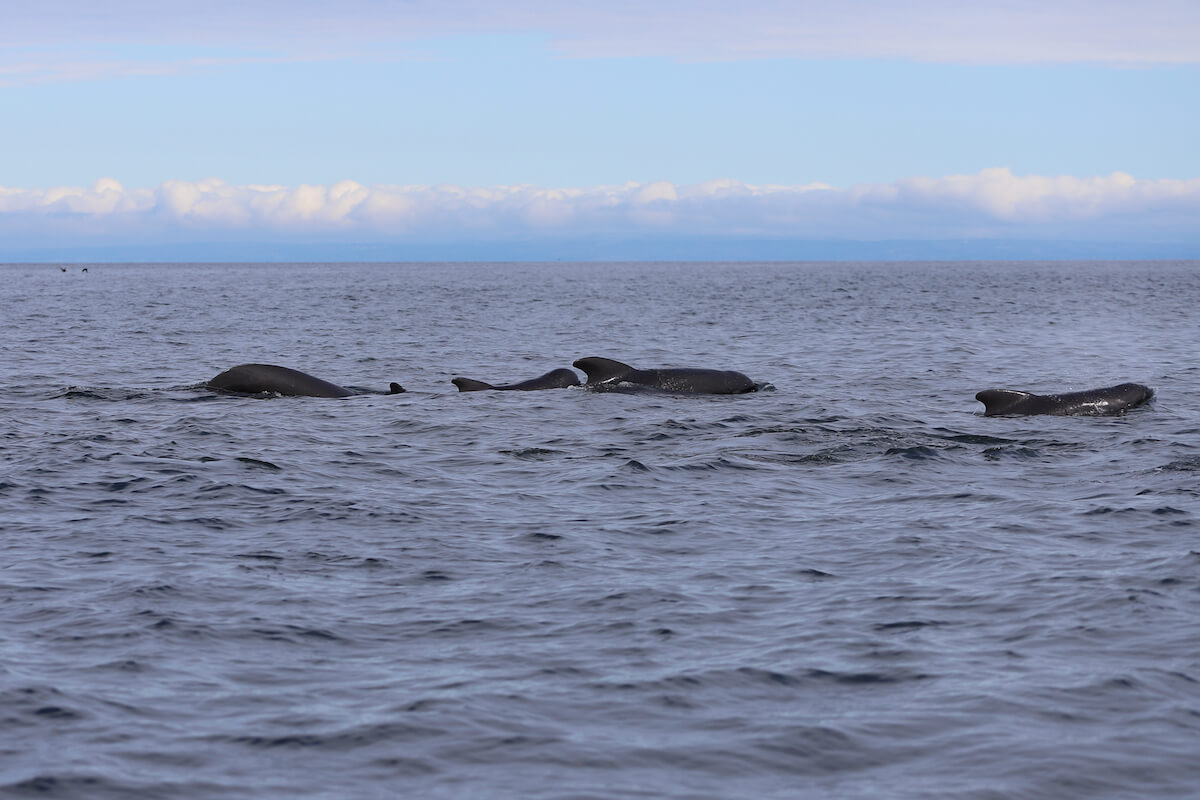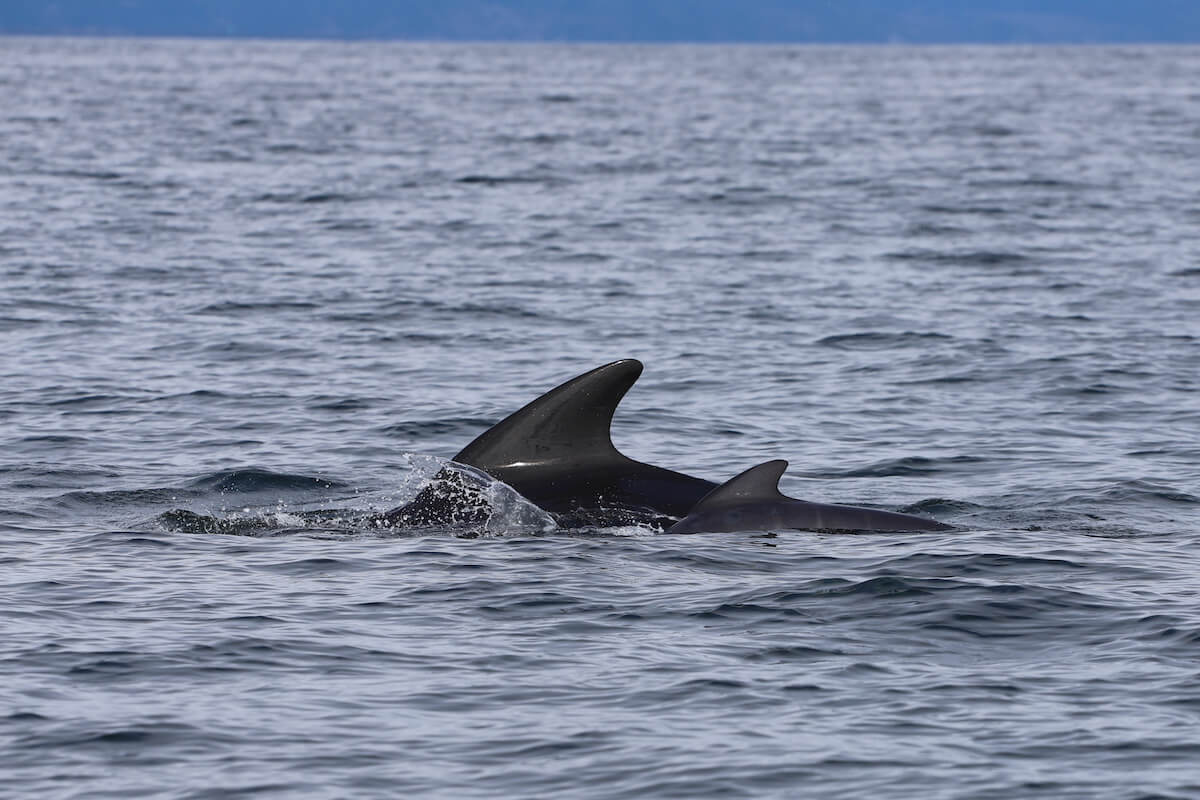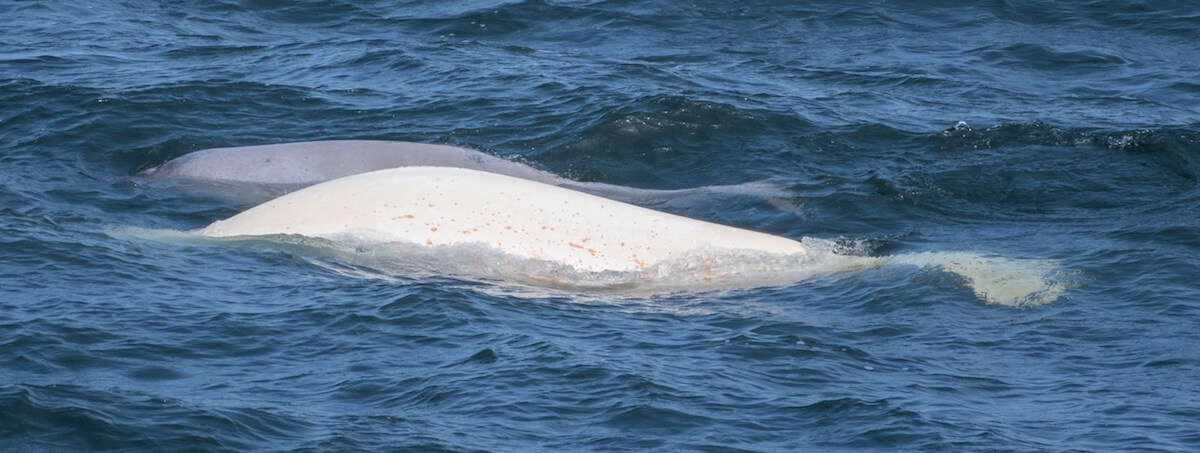It is perhaps the least known marine mammal species in the St. Lawrence. And for good reason: sightings are occasional in the Gulf, and rare in the Estuary. So when René Roy, during his first trip out to sea, found himself in a group of about twenty pilot whales off the coast of Franquelin in Quebec’s Côte-Nord region, he celebrated!
The pilot whale is a species of dolphin with a rounded head like that of a beluga (though the beluga does not belong to the dolphin family). Its broad dorsal fin looks more like that of the harbour porpoise than the sickle-shaped fin of the Atlantic white-sided dolphin. Its long, slender pectoral fins are unique. A paler patch on its back is reminiscent of the largest species of dolphin: the killer whale.
Pilot whales are highly social and live in communities. This species is notorious for its mass strandings, which is where the pilot whale gets its name. More precisely, it is possible that when one pilot whale beaches itself, the rest of the pod imitates it and becomes stranded as well.
During René’s sighting, the group comprises at least one calf, several females and at least one male, probably an adult given its shape and size. Pilot whales tend to remain in family units that sometimes comprise up to 20 or so related individuals. Is that the case with this group?
A loyal collaborator of the Mingan Island Cetacean Study , René is accustomed to sharing his observations with researchers. He therefore forwarded his photos to the Cape Breton Pilot Whale Project, which maintains a photo-identification catalogue for the species. Researcher Elizabeth Zwamborn was unable to identify the individuals, much to her surprise. She notes that in the past several years sightings in the Gulf have drastically declined and that pilot whales are seldom seen outside of July and August. Has there been a change in the abundance or distribution patterns of the species’ primary prey, the short-finned squid?
This is the third time René has crossed paths with pilot whales, and the other two times were also in May (you can read his Field Notes on the subject). Once again, whales never cease to amaze us!
Video credit: René Roy
Observations on the rise
On May 7, there is no shortage of whale sightings along the North Shore. At Pointe-Paradis, an observer spots a fin whale and a minke whale one after the other. In Franquelin, huge white columns form a blotch on the horizon that persists for a few seconds before dissipating. Despite having binoculars, he is unable to identify the species that produced this offshore geyser. Near Les Escoumins, two belugas are spotted swimming languidly.
On May 8, a birder begins his day at the dunes of Tadoussac. He is pleased to note a passing minke whale. Later that day, he migrates to the rocks of Essipit, where he photographs a beluga that shows odd speckling on its skin. Intrigued, he sends his photo to the Group for Research and Education on Marine Mammals. The team is amazed, as they have never seen spots of this colour and shape. The photo is promptly shared with wildlife veterinarian Stéphane Lair. The yellow patches could be a buildup of keratin associated with moulting and therefore part of a normal process. However, it is possible that the beluga has slowed down its pace and therefore shed less skin when swimming. In the photo, it is accompanied by a young beluga. Did it slow down too much so that the little one could keep up?
On May 8, a birder begins his day at the dunes of Tadoussac. He is pleased to note a passing minke whale. Later that day, he migrates to the rocks of Essipit, where he photographs a beluga that shows odd speckling on its skin. Intrigued, he sends his photo to the Group for Research and Education on Marine Mammals. The team is amazed, as they have never seen spots of this colour and shape. The photo is promptly shared with wildlife veterinarian Stéphane Lair. The yellow patches could be a buildup of keratin associated with moulting and therefore part of a normal process. However, it is possible that the beluga has slowed down its pace and therefore shed less skin when swimming. In the photo, it is accompanied by a young beluga. Did it slow down too much so that the little one could keep up?
On May 10, in front of the Marine Mammal Interpretation Centre in Tadoussac, a mother minke whale begins to pass on her hunting techniques to her calf. For the new manager of the museum’s boutique, this observation is a beautiful start to the season and confirms that her decision to leave the big city will bring her much satisfaction.
Between Sept-Îles and Anticosti Island on May 11, a few animals pierce the glass-like water surface: a minke whale, small groups of harp seals and harbour porpoises. All of these species are fond of small fish. Did they find a large school to feast upon? A minke whale is also spotted near Pointe-des-Monts that same day.
In the Charlevoix region, beluga observations are coming in nearly daily now. In both Saint-Irénée and Cap-à-l’Aigle, belugas seem to waddle their backs early in the evening. Unless it is the observers that are just paying more attention to them at this time of day when the light is excellent to contemplate the grandiose St. Lawrence. Because the best whale-watching tip is to never take your eyes off the water!
So there you have it… this is my last weekly observation column, after authoring it for nearly four years. I would like to extend a warm thanks to the loyal observers who have shared their love for whales with me every week. This column helps forge ties with others while facilitating the exchange of knowledge and experiences. I had great pleasure talking to them week after week, getting a glimpse into their lives and those of the whales they care so much about. My colleague Laure Marandet will take over the column and will be pleased to hear your feedback. Because without your eyes on the water, her work would be all for naught.








